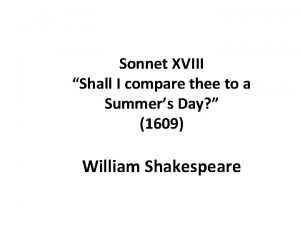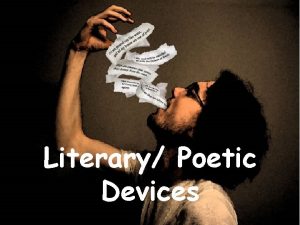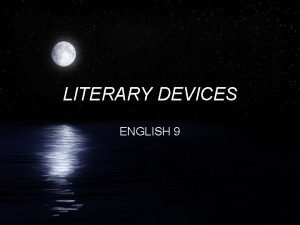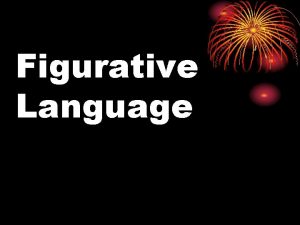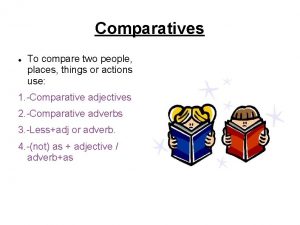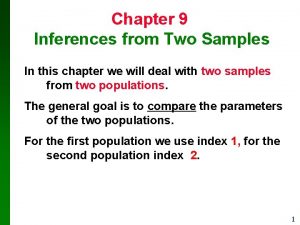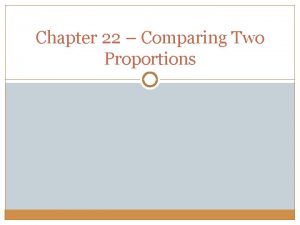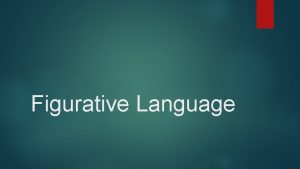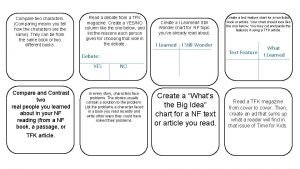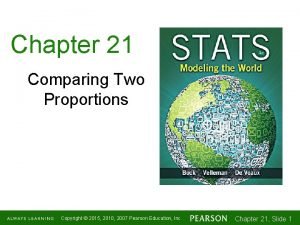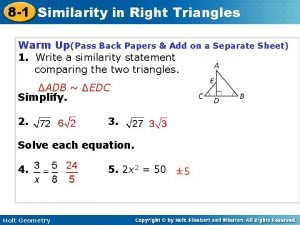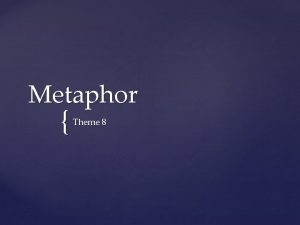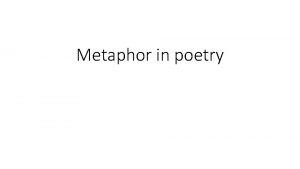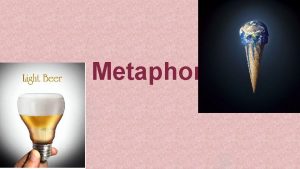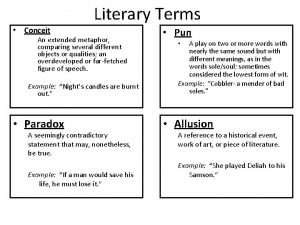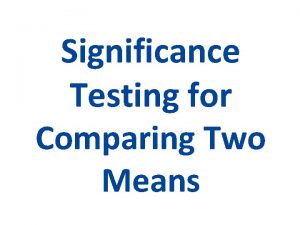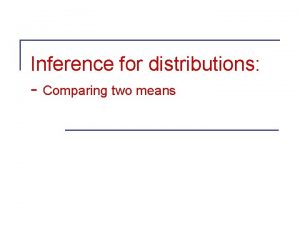Poetry Terms Comparisons in Poetry Metaphor comparing two















- Slides: 15

Poetry Terms

Comparisons in Poetry • Metaphor: comparing two things that are not the same. • Example • The baby is a sour lemon • Comparing the baby and the lemon • Example • My friend is a rock • Comparing the friend and the rock

Comparisons in Poetry • Simile: Comparing two things that are not the same, but you are using, “like” or “as” • Example • The stars are like diamonds in the sky • Comparing stars to diamonds • Example • My friend is like a rock • Comparing friend and rock

Poetry Terms • Alliteration • Repeating the same letter (same sound) at the beginning of the words • Example • lady lounges lazily • (L sound is repeating) • The moan of doves in immemorial elms, And murmuring of innumerable bees. • (M sound is repeating)

Poetry Terms • onomatopoeia is a figure of speech that employs a word, or occasionally, a grouping of words, that imitates, echoes, or suggests the object it is describing: • Examples • "bang", "click", "fizz", "hush" or "buzz", • or animal noises such as "moo", "quack" or "meow".

Poetry Terms • Hyperbole • A figure of speech (a form of irony) in which exaggeration is used for emphasis or effect; an extravagant statement. • I could eat a horse. • Running faster than the speed of light • I waited in line for centuries • Hyperboles could look like similes • He is as tall as the CN Tower. • He is as fast as the speed of light

Alliteration poems • Continue the alliteration poem. This is the first line of the poem. Come up with 8 more lines for this poem. Include two other terms that we have covered in class. (Metaphor, simile, hyperbole, onomatopoeia. ) • Sudden storm startles spectators • Porky pig picks on purple penguins • Cheering crowd claps confidently • Fair weather fans finally flee • Molly Mumbley munches on messy mangoes • Yuri Yawney yells at yellow yaks •

Personification • Literary term that gives human qualities to non human things • Example • The storm sang a beautiful song on that stormy day. • Storm- human quality is singing • Example • The wind spoke to me yesterday.

Personification • Make the non living object an example of personification. Come up with a sentence giving a human quality to a non human thing. • • 1. sun (sings) 2. boat (cries) 3. storm (yells) 4. tree (stretch) 5. car (coughed) 6. tires (screams) 7. television (weeps) 8. computer (laughed) 9. essay (yelled) 10. car (cried) 11. pencil (talks) 12. pen (yawns)

Casey at Bat • Why were the Mudville fans down at the beginning of the poem? • Find an example of a simile, and personification from this poem? • Why was everyone happy when the Casey came up to bat? Find an example from the poem? • How would you describe Casey as a person? Find an example from the poem? • How would you describe the mood of the poem after Casey let the ball go past him a second strike? • What is the climax in this poem? • How did the fans feel at the end of the poem?

Poetry Terms • Assonance: • Assonance is the repetition of vowel-sounds within nonrhyming words. • In Poe's, "Bells" he uses assonance of the vowel "e: “ • Hear the mellow wedding bells. • Assonance of the vowel "u" used by Robert Louis Stevenson: • The crumbling thunder of seas

Poetry Terms • Consonance: • Consonance is the repetition of consonant sounds within words. • Consonance is very similar to alliteration, but the distinction between the two lies in the placement of the sounds. • If the repeated sound is at the start of the words, it is alliteration. If it is anywhere else, it is consonance. In most cases, consonance refers to the end sound (like "nk" in blank and think • Example • Lady lounges lazily • (Repeating “l” sound) • Dark deep dread crept in • (Repeating “d” sound)

Poetry Terms • Oxymoron • Placing single word opposites beside each other for dramatic effect • Example • Hot ice • (Hot-warm) (ice-cold) • Jumbo shrimp • (jumbo-large) (shrimp- small)

Oxymoron • State what is the oxymoron in the following sentences 1. The student teacher taught our class the other day. 2. The students brought a jumbo shrimp platter to the party. 3. The criminal’s cruel kindness was on display in the court room. 4. “I’m almost done!” said the student. 5. The police are trying to sort through the accurate rumors that the received from the community. • 6. The girl is awfully pretty to be wearing that dress to the party. • 7. The Great Depression was one subject we covered in history. • 8. I am all alone here at the drugstore. • • •

Poetry Terms • Mood • The emotion of the poem. The predominant feeling in the poem • Tone • The narrator’s attitude toward the subject of the poem and, sometimes, toward the reader of the poem • • Symbol Something that represents something else Dove-peace Red- Danger
 Figures of speech simile
Figures of speech simile Shall i compare thee to a summer's day annotation
Shall i compare thee to a summer's day annotation Literary devices in the jungle
Literary devices in the jungle Metaphor meaning in literature
Metaphor meaning in literature Like terms and unlike terms in polynomials
Like terms and unlike terms in polynomials Identifying like terms
Identifying like terms Whats the definition of simile
Whats the definition of simile A comparison of two dissimilar things
A comparison of two dissimilar things Comparing two people
Comparing two people Comparing two population variances
Comparing two population variances Chapter 22 comparing two proportions
Chapter 22 comparing two proportions Chapter 10 comparing two populations or groups answer key
Chapter 10 comparing two populations or groups answer key Figurative language comparing two things
Figurative language comparing two things Comparing two characters
Comparing two characters Ap stats chapter 21 comparing two proportions
Ap stats chapter 21 comparing two proportions 8-1 similarity in right triangles answer key
8-1 similarity in right triangles answer key

